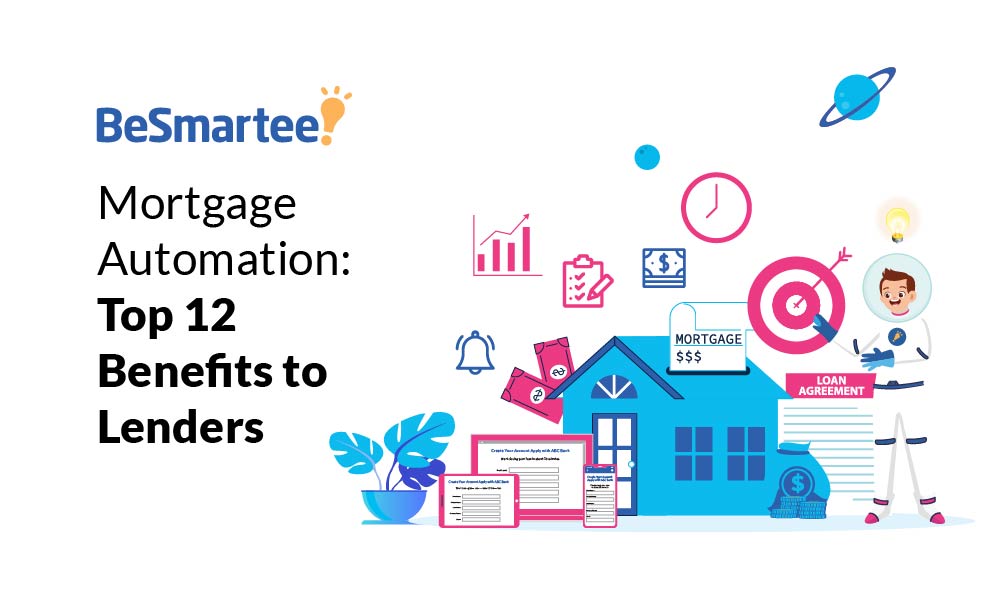The benefits of mortgage automation go without saying but part three of our series takes a deeper look at the advantages of smart automation.
According to Cognizant, 60 to 70 percent of mortgage processes are perfect candidates for automation and while many lenders have embraced full or partial automation, some still haven’t taken the plunge.
KPMG Advisory principal Bill Cline stated, “Success in today’s complex global financial markets requires unprecedented levels of speed, accuracy and cost-efficiency beyond what a human workforce can provide,” and AI and machine learning are proving to be the keys to success.
1. Reduces Cycle Time
Taking a loan application start to finish isn’t a simple task. Automating repetitive tasks in the loan application process streamlines the workflow allowing for higher levels of speed and efficiency.
AI technology, such as digitizing and indexing documents with optical character recognition (OCR), text analytics for easy accessibility and algorithms that make credit decisions and assess customer risk levels greatly reduce the amount of time and labor that goes into each application.
Cutting out the points of friction and bottlenecks below gives mortgage automation technology the ability to streamline the entire workflow and shorten the origination time.
- Review of applications
- Verification of application information
- Contacting third parties for appraisals and property information
- Submitting loan files to underwriters or loan closers
- Informing supervisors of discrepancies
- Creating and sending loan approval or rejection letters
By using AI technology and automation, Union Bank was able to reduce the turnaround time for digitizing loan documents from 15 days down to 5 days. Making documents easily accessible in an electronic format means the cycle time for loans is much quicker compared to manual methods.
2. Improves Loan Quality
Out of every 100 steps in repetitive tasks, a human is likely to make 10 errors. Mortgage automation improves the loan quality by leaving little room for error.
Loan officers deal with stacks of documents, emails, faxes, face-to-face interactions, phone calls, texts and uploaded documents. These documents involve sensitive financial information of customers that needs to be tracked and referenced. Doing all of this manually takes time and effort, and if something is lost or misplaced, the process comes to a complete stop.
3. Increases Productivity
The reduction in lost time means there’s a potential for increased productivity. Creating a Digital Workforce released by Kofax Intelligent Automation, reported that automation increases staff productivity, service levels and capacity by 35 to 50 percent.
Employees can only work so fast and so much in a single day but machines can work all day and night without breaking a sweat. Automation gives companies and staff back their time to focus on tasks and areas that cannot be done by machines.
4. Reduces Costs
Issues in loan processing systems and human error cost money!
In the study Automating Mortgage Loan Processing conducted by SourceMedia Research, half of the respondents at financial institutions with less than $1 billion in assets reported 10 or more incidents per month involving missing customer documentation. Nearly a fifth of respondents presumed the costs from compliance and processing errors to range from $100,000 to $1 million or more.
A reduction in processing time and manual labor is another money-saver for mortgage companies. A 2019 article released by HousingWire claimed that SoftWorks AI, an AI and machine learning software company, has shown reductions in manual labor to save in excess of 50 percent in both pre-underwriting and underwriting.
5. Predictable Revenue
Revenue forecasts affect annual budgeting and planning. Inaccurate projections mean missed targets and performance reductions. Predictable revenue can be achieved through end-to-end process equilibrium with intelligent automation.
Automating mortgages ensures each process is executed within the same timeframe with consistent turnaround times and data accuracy. Because of process uniformity and data analytics, mortgage companies can forecast their expected revenue for the year.
6. Scalability
For a business to grow, it needs to continually meet demands and adapt to market changes and business needs in real-time. If your system doesn’t scale to meet business requirements, this creates a bottleneck for growth.
Automation scalability focuses on three aspects:
- The ability to handle increased workloads;
- The ability to expand the scope of usage;
- The ability to increase the extent of access by allowing your system to access other applications or be exposed to other processes.
Workflow solutions that aren’t scalable as businesses grow are expensive to adapt. Automated mortgage loan processing platforms are effortlessly scalable.
7. Superior Fraud Detection
Mortgage fraud is still a problem in the U.S., with one out of every 123 mortgage applications having indications of fraud in 2019. Common mortgage fraud scams include identity theft and falsification of income or assets and the FBI calculates that fraud costs the mortgage industry at least $1 billion per year.
Subscribe to BeSmartee 's Digital Mortgage Blog to receive:
- Mortgage Industry Insights
- Security & Compliance Updates
- Q&A's Featuring Mortgage & Technology Experts
There are too many transactions to accurately detect and flag irregularities with the human eye. Automation technologies let lenders catch discrepancies early in the loan application process by flagging applications that show an elevated risk of fraud.
8. Better Customer Experience
Because technology delivers almost instantaneously, it’s what we’ve come to expect as a society. Nobody wants to wait up to six weeks for a traditional “purchase without problems” loan decision.
Mortgage automation means faster and more efficient loan processing which makes for happy customers. Customers expect speed, transparency, convenience and personalization, and they should. A mortgage is one of the biggest financial transactions a person will make in their life.
Automation also allows mortgage companies to better connect with their borrowers. Staff are no longer tied down by repetitive tasks and can focus on customer service.
Ellie Mae’s 2019 Borrower Insights Survey shows that borrowers are asking for more communication throughout the loan origination process.
This data also disclosed that communication across multiple channels between mortgage lenders and borrowers increased by 20 percent for those who took out loans within the last year compared to borrowers who acquired their loan within the last three to five years.
This survey also found that millennials and Gen Xers used more methods of communication to connect with their lender more frequently when compared to baby boomers. Direct communication across multiple channels is especially important to young borrowers who are applying for a mortgage for the first time.
9. Deeper Insights for Process Improvement
Big data technology has brought a wealth of invaluable information to the mortgage industry which has resulted in improvements to the mortgage loan process. Advanced analytics highlight areas that are doing well and areas where there’s room for refinement.
Analytic tools can:
- Determine which customer factors have the best influence on loan performance and target applicants with these characteristics
- Establish which loan structures and terms lower risk default
- Identify characteristics of applicants that lead to delinquencies and apply strict qualification criteria
- Target unnecessary manual tasks in the loan origination process that can be automated with decision rules
Analytic tools monitor system performance and provide insight for lenders to improve and remain competitive.
10. Consistent and Defined Workflows
Consistent workflows can do wonders for productivity by laying a solid foundation for business operations with less room for error. Automation and rule-based efficiencies make the mortgage loan process consistent with a defined workflow for both the front and back office.
11. Compliance With Regulatory Demands
Mortgage lenders are required to adhere to strict state and federal regulations. The Consumer Financial Protection Bureau (CFPB) is pushing lenders to find new ways to comply with CFPB standards of lender accuracy, transparency and standardization.
Compliance with CFPB is made easier by a defined framework of automated tasks and decision-making that gives uniformity to the lending process. Reducing risk and improving loan quality and consistency can help lenders avoid non-compliance consequences.
12. Multichannel Digital Notification
Every task in the loan process requires a response more easily fulfilled by automation. Lenders can send information via email, print and text message.
Not only does this reduce the amount of manual work, but automated digital notifications have reduced the cost of printing and mailing and gives lenders the ability to keep records of these notifications for regulatory compliance purposes.
Roundup
Many industries have reaped the benefits of workflow automation. While the mortgage industry has been slow to adopt these systems, modern mortgage lenders recognize a need to integrate digital mortgage technology to remain competitive and efficient, while providing excellent customer service and staying compliant with regulatory demands.
Are you ready to leverage the benefits of automation?
Learn how lenders use BeSmartee’s mortgage automation tools to improve the workflow process, close more loans and keep customers happy. Call us at (888) 276-1579 or reach out to our mortgage technology experts at sales@besmartee.com today.




